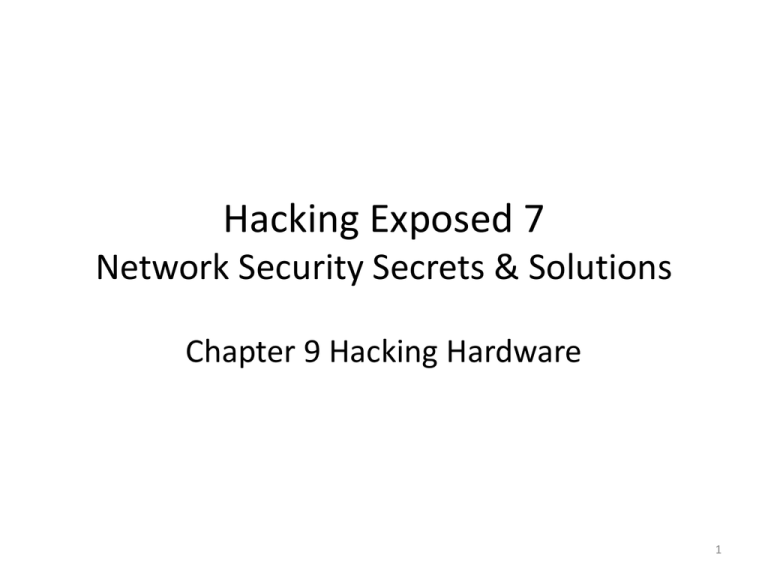Hacking Exposed 7 ch..
advertisement

Hacking Exposed 7 Network Security Secrets & Solutions Chapter 9 Hacking Hardware 1 Hacking Hardware outline • Physical Access: Getting In The Door • Hacking Devices • Reverse Engineering Hardware 2 Physical Access: Getting In The Door Cloning Access Cards 1. Magnetic stripe • Contain three tracks of data, e.g., ID number, serial number, name, address, etc. • No security measures to protect data • Not clear encoding – Tools • A magstripe card reader/writer – Magnetic-Stripe Card Explorer (software) – Read » read multiple cards of the same type to detect the different bits – Write » determine what checksum is used recalculate a new one 3 Physical Access: Getting In The Door Cloning Access Cards 2. RFID • Most cards access RFID on two different spectrums – 135 kHz or 13.56 MHz. – Many RFID cards are unprotected » Recently, more RFID cards employ cryptography – Hardware tools are available at Openpcd.org for the reader/writer – More advanced reader/writer tools: » Proxmark3 + on-board FPGA for the decoding of different RFID protocols » Universal Software waves Radio Peripheral (USRP) to intercept the RFID traffic • Send and receive raw signals (capture and replay) – Countermeasures for Cloning Access Cards • Original: Card vendor saves cost – Access technology as inexpensive as possible • Now: Fully cryptographic to prevent cloning, replay, etc. – Private key stored on the card – Challenge-response algorithm » Card send private key (challenge) to reader » Reader provides a valid answer (response) to card 4 Hacking Devices Locked Hard Disk – Bypassing ATA (Advanced Technology Attachment) password security – ATA security to deter the usage of a stolen laptop • ATA requires users type password before bios access hard disk – Common and simple trick Hot-swap attack (Fool BIOS) • Hot-swap attack steps – Find a computer (capable of setting ATA password and an unlocked drive) – Boot the computer with the unlocked drive – Enter BIOS interface prepare to set a BIOS password – Replace the unlocked drive with the locked drive (Carefully) – Set the harddisk password using BIOS interface The drive will accept the new password – Reboot BIOS prompt you to unlock the drive bypassing the old one. – The password can be cleared from the system if a new password is not desired. 5 Hacking Devices Locked Hard Disk – Countermeasures • The best defense –Do not rely on ATA security to protect drives • Alternatively, use full disk encryption products –Bitlocker –TrueCrypt –SecurStar 6 Hacking Devices USB U3 Hack to a System – Easiest ways into a system – U3 system is a secondary partition • USB flash drive made by SanDisk and Memorex • U3 menu is executed automatically when USB stick is inserted. – Hack work by taking advantage of Win auto run feature – Autorun.ini in U3 partition runs • U3 partition can be overwritten • Attack by reading the password hashes from the local Windows password file or install a Trojan for remote access – Universal_Customizer.exe write ISO containing Fgdump script into flash disk – Countermeasures • Disable auto run (Check Windows support for how to) • Hold SHIFT key before inserting USB. – Prevent auto run from launching the default program. 7 Hacking Devices Hack Phone by Bluetooth – Bluetooth can hack phone sync, make calls, transfer data, etc. (nearly Bluetooth protocol) • Steal contacts, social engineering – Ubertooth, a hardware tool, for sniffing and playback of Bluetooth frames • 80 Bluetooth channels in 2.4 GHz ISM band • Spectrum analysis 8 Reverse Engineering Hardware IC Chips – To unlock the information inside – Mapping the device • Identify Integrated Circuit (IC) chips – Google IC data sheet packaging, pin diagram, etc. • Available external interfaces – HDMI, USB, JTAG, etc. • Identifying important pins – Modern boards are multilayer (Difficult) – Use multimeter (toning function) to create bus map » Beep when a wire is connected 9 Reverse Engineering Hardware IC Chips –Sniffing bus data • Generally unprotected Man-in-the-middle attack – intercept, replay • Encrypted information as chip to chip – DRM (Digital Right Management) systems » E.g., HDMI-HDCP • (High-bandwidth Digital Content Protection) • Use a logic analyzer to see and record signal on the bus – Some provide built-in decoders for I2C, SPI, Serial 10 Reverse Engineering Hardware Sniffing Wireless Interface – Layer 2 software attack – Hack steps • Identify FCC ID of the devices – Useful information » Radio frequencies on which the device is to operate. » Internal diagrams • Symbol decoding – Radio frequencies + type of modulation – Decode lowest level bits from wireless channel – Software-Defined Radio » WinRadio or USRP 11 Reverse Engineering Hardware Firmware Reversing – A plethora of juicy information about the device • Default passwords, admin ports, debug interfaces. – Hex editor (Hex ASCII) – 010 editor and IDA pro – Guess AES (Advanced Encryption Standard) encryption is being used – EEPROM programmers – Read firmware file 12 Reverse Engineering Hardware Firmware Reversing – ICE (In Circuit Emulator) Tools • An in-circuit emulator • Hardware debugger – JTAG (Joint Test Action Group) • Testing interface for printed circuit boards (PCB) • UrJTAG 13 Homework Ch9 (1/2) (100 points) 1) (60 points) Hacking (a game) ROM 1.1) Learn how to hack a game ROM from this link http://www.nintendoage.com/forum/messageview.cfm?catid=22&th readid=19733 1.2) Change 2 PLAYER GAME in menu to 2 Your Name GAME, e.g., I change the 2 PLAYER GAME to 2 EKARAT GAME. Capture and paste your change. * You can download the target game rom (Super Mario Adventure (SMB1 Hack).nes) at the course webpage. 14 Homework Ch9 (2/2) 2) (20 points) Use your Hex editor to modify any programs you want, and tell us 2.1 What is the target program? 2.2 What is your modification? Show the captured screen of the result. 3) (20 points) Do a research. What are the difference between PlayStation4 and PlayState3 in terms of hardware aspects? 15





